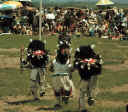

What is Tourism? On-Line Lesson
Since the beginning of time humans have traveled. Food, water, safety or acquisition of resources (trade) were the early travel motivations. But the idea of travel for pleasure or exploration soon emerged. Travel has always depended upon technology to provide the means or mode of travel. The earliest travelers walked or rode domesticated animals. The invention of the wheel and the sail provided new modes of transportation. Each improvement in technology increased individuals' opportunities to travel. As roads were improved and governments stabilized, interest in travel increased for education, sightseeing, and religious purposes. One of the earliest travel guides was written by Pausanias, a Greek, which was a 10 volume Guide to Greece, for Roman tourists in 170 A.D..
Tourism is a collection of activities, services and industries that delivers a travel experience, including transportation, accommodations, eating and drinking establishments, retail shops, entertainment businesses, activity facilities and other hospitality services provided for individuals or groups traveling away from home. The World Tourism Organization (WTO) claims that tourism is currently the worlds largest industry with annual revenues of over $3 trillion dollars. Tourism provides over six million jobs in the United States, making it the country's largest employer.
![]()
Definition of Tourism
Mathieson and Wall (1982) created a good working definition of tourism as "the temporary movement of people to destinations outside their normal places of work and residence, the activities undertaken during their stay in those destinations, and the facilities created to cater to their needs."
According to Macintosh and Goeldner (1986) tourism is "the sum of the phenomena and relationships arising from the interaction of tourists, business suppliers, host governments and host communities in the process of attracting and hosting these tourists and other visitors."
Other terms of interest are:
Excurionist: Persons traveling for pleasure in a period less than 24 hours (Macintosh and Goeldner, 1986).
Foreign Tourist: Any person visiting a country, other than that in which he/she usually resides, for a period of at least 24 hours (Committee of Statistical Experts of the League of Nations, 1937).
Travel: The act of moving outside one's home community for business or pleasure but not for commuting or traveling to or from school (Macintosh and Goeldner, 1986).
Visitor: Any person visiting a country other than that in which he/she has his/her usual place of residence, for any reason other than following an occupation remunerated from within the country visited (United Nations Conference on International Travel and Tourism, 1963).
![]()
Transportation Systems
The type and availability of transportation will determine travel destinations. The development of accommodations were likewise determined by the development of transportation systems. These systems are listed below.
|
Grand
Canyon Railroad |
![]()
Dimensions of Tourism
All tourism activities are related to one or more of the following dimensions of tourism.
Attractions: Are the primary motivation for traveling. They may be a primary destination such as Disney World or secondary destination which are interesting places to visit on the way to your primary destination. Most tourist traveling from the east to go to Las Vegas will stopover at the Grand Canyon national Park on the way. Attractions usually focus on natural resources, culture, ethnicity or entertainment.
|

Buffalo Dancers |
Facilities: When tourists arrive at attractions they require facilities to provide services.
Lodging: Represent a variety of services from campgrounds, RV parks, motels and five star resorts. | |
Food & Beverage: Not only provide basic sustenance for tourists but an important factor in the overall tourism experience. | |
Support Services: Usually are represented by small retail businesses providing souvenirs and personal services. Shopping is an integral part of the travel experience. Tourists seek unique and novel items which represent the area and cultures they visit. | |
Infrastructure: The basic services on which all tourism depends. These systems include water and sewer systems, communication networks, medical facilities, electricity, police and fire protection and roads. |
Transportation
Time and Money: This is the critical component to tourism, the ability to get from Point A to Point B and back, or to Point C, D, E.... The variables of Time, how long it takes to get to a specific destination, and Money, how much it costs to get to your destination. Tourism developments are dependent on the ease of access and types of transportation available. |
Hospitality
Hospitality: The community's attitude which permeates every tourism location that makes the tourist feel welcome and safe. It is the result of the interaction between the tourist and the local population. |
![]()
Essential Requirements for Tourism
Time, as the hours for leisure increase so does the opportunity for travel. Changes in work days or hours, school calendars will affect how and when people can travel. The overall travel pattern has moved from a two week vacation to 6-8 three or four day mini-vacations per year.
Money, the majority of travel requires discretionary income. Discretionary income is money left over after all monetary obligations (food, rent and taxes) have been paid.
Mobility, is the access to transportation (car, bus, plane, train or ship) and the hours required to get to their destination.
Motivation, is the reason people travel. Motivations may include seeking novelty, education, meet new people, adventure or stress reduction.
![]()
For a complete discussion of the issues surrounding tourism development See National Environmental Plan (International Society for Environmental Protection).
![]()
![]() Copyright
1998 Northern Arizona University, ALL RIGHTS RESERVED
Copyright
1998 Northern Arizona University, ALL RIGHTS RESERVED